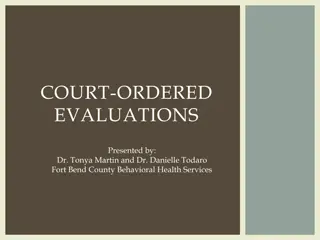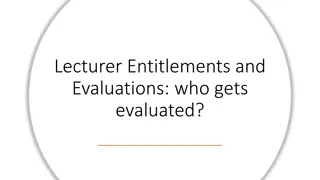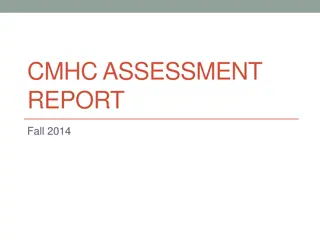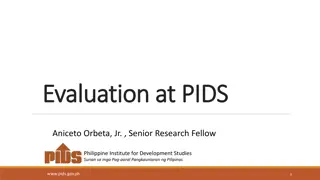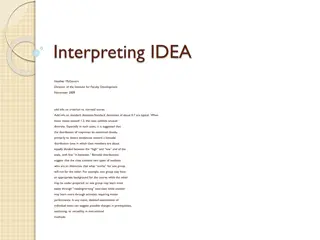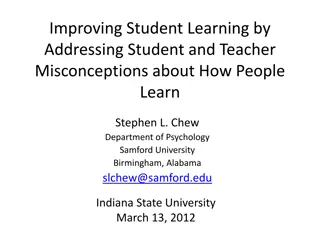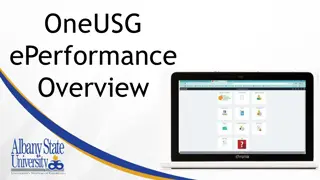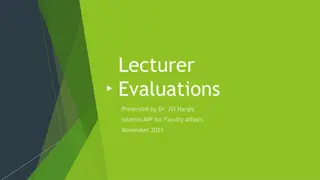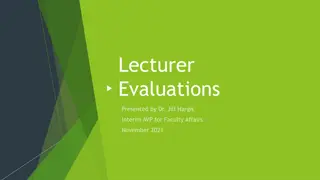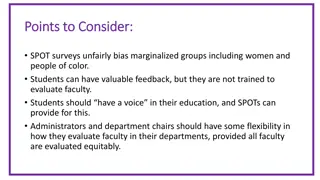Understanding Student Evaluations of Teaching and the Importance of SEEQ
Explore the reasons behind preferring SEEQ over IDEA for teaching evaluations at Wittenberg, focusing on the dimensions of learning, decision-making process, reliability, validity, customization, and reporting speed. SEEQ was developed based on essential characteristics of a superior college teacher, offering a comprehensive evaluation tool for instructors and programs.
Download Presentation

Please find below an Image/Link to download the presentation.
The content on the website is provided AS IS for your information and personal use only. It may not be sold, licensed, or shared on other websites without obtaining consent from the author. Download presentation by click this link. If you encounter any issues during the download, it is possible that the publisher has removed the file from their server.
E N D
Presentation Transcript
Student Evaluations of Teaching TUESDAY 9/27 4:30PM PRESENTED BY THE TEACHING EFFECTIVENESS COMMITTEE: AMBER BURGETT, JUSTIN HOUSEKNECHT, WENDY GRADWOHL, IRENE PRESPER , OLIVIA MILLER
Evaluating Teaching Peer evaluations
Why not the IDEA? Survey in March 2015 showed that the IDEA was not well understood, liked, or utilized 11. Do you have a preference for which evaluation instrument you would like to see used at Wittenberg? 1. I am satisfied with the current IDEA form evaluations. 25 16 14 20 12 10 15 8 10 6 4 5 2 0 0 disagree neutral agree Prefer the SEEQ no Prefer the IDEA preference
Why the SEEQ? Evaluated 6 SETs IDEA, SEEQ, SPTE, CIEQ, SIRII, IASystem, & Panorama Number of items per domain, applicability to non- lecture courses, & tone SETs used for Personnel decisions Teaching improvement Program assessment
Why the SEEQ? Decision making process Reliability Similar for IDEA & SEEQ Validity Stronger for SEEQ Customization More flexibility Reporting Quicker for SEEQ
What is the SEEQ? 8 Dimensions of Learning Learning Individual Rapport Enthusiasm Breadth Organization Examinations Group interaction Assignments Comment section after each dimension
Development of SEEQ Items based on 19 essential characteristics of a superior college teacher developed by Feldman (1976) First SEEQ developed at UCLA Extensive item pool developed based on current practices, interviews with students and faculty, and review of evaluation literature Pilot surveys with 5-75 items given to classes in various academic departments; students not only evaluated their instructor with the items but were asked to indicate items that were most reflective of quality of teaching and whether there were any items that had been excluded; instructors asked to indicate items that would be most useful in improving their teaching Four criteria used to select items to be included on the UCLA version of SEEQ: 1) student ratings of item importance 2) staff ratings of item usefulness 3) factor analysis 4) item reliabilities
Reliability Evidence Reliability Intraclass correlation (agreement among ratings within each class) is approximately .90 when ratings are based on 25 or more students v. .74 when ratings are based on only 10 respondents (Marsh, 1987) Coefficient alpha (agreement among different items created to measure the same factor) is between .88 and .97. Good agreement between responses by current and former students (Marsh, 1987) Long-term stability UCLA study found that students asked to provide retrospective ratings of teaching effectiveness in 100 classes one year after graduation (and several years after taking a course) were correlated .83 with teaching evaluations assessed at the end of the term (Overall & Marsh, 1980).
Validity Construct validity Factor analysis Nine factors based on student as well as faculty ratings from different academic disciplines across years (e.g., Marsh & Overall, 1979b; Marsh 1983, 1984, 1987; Marsh & Dunkin, 1992) and across countries (e.g., Marsh, 1981a) Faculty self evaluations Correlation between student and faculty ratings on the same factors statistically significant for all factors (median r=.49) Held for all levels undergraduate and graduate Multitrait-multimethod analysis correlations between ratings on different factors were low Criterion-related validity (i.e., student learning) Study in which multiple sections of the same course taught by different instructors (in which students don t know who will be teaching the section) using the same text, course outline, course objectives, etc. sections that evaluated teaching most favorably during the last week of classes did better on the standardized exam given to all sections the following week (Marsh et al., 1975; Marsh & Overall, 1980) More favorable affective responses to items such as course mastery, plans to apply the skills gained from the course, plans to pursue the subject further correlated with teaching evaluations (Marsh et al., 1975; Marsh & Overall, 1980) former-student and student ratings evidence substantially greater validity coefficients of teaching effectiveness than do self-report, colleague, and trained observer ratings (p. 195, Howard et al., 1985)
Correlation between dimensional ratings and student achievement Structure (.55) Interaction (.52) Skill (.50) Overall course (.49) Overall instructor (.45) Learning (.39) Rapport (.32) Evaluation (.30) Feedback (.28) Motivation (.15) Difficulty (-.14) Example interpretation: Students rating of class structure is highly correlated with grade in the class. In other words, students who rated the class structure higher also earned a better grade in the class.
Bias in SETs No instrument is perfect Bias does exist in SETs (gender, race, class size, subject matter, etc.) No tool should be used in isolation Peer evaluations
Logistics of administering the SEEQ Live 2 weeks before last day of semester 1st half semester: 10/10/16 All other fall courses 11/25/16 Closes last day of classes Reports available 24 hours after grades are due
Accessing student evaluations Students will receive an email with a link to login page There will be an evaluations link on the MyWitt homepage Mobile friendly access through email link or eval.wittenberg.edu One email and login location for all evaluations
Adding course specific questions You are also able to access the student evaluations through the evaluations link on MyWitt Or use eval.wittenberg.edu/admin
Adding course specific questions Student evaluations of teaching user manual
Accessing your results Results will be available 24 hours after final grades are submitted
Accessing your results Choose course
Accessing your results Choose learning dimension or add on questions
Results for Learning Dimension
Results for Organization Dimension
Accessing your results Download raw data using evaluation export
Accessing your results Reports selections coming soon! Course summary, tenure prep, and chairs report
Other features Department specific questions can be added Access all your evaluation results in one place!
References Feldman, K.A. (1976). Grades and college students evaluations of their courses and teachers. Research in Higher Education, 4, 69-111. Howard, G.S., Conway, C.G., & Maxwell, S.E. (1985). Construct validity of measures of college teaching effectiveness. Journal of Educational Psychology, 77, 187- 196. Marsh, H.W. (1982). The use of path analysis to estimate teacher and course effects in student ratings of instructional effectiveness. Applied Psychological Measurement, 6(1), 47-59. Marsh, H.W. (1983). Multidimensional ratings of teaching effectiveness by students from different academic settings and their relation to student/course/instructor characteristics. Journal of Educational Psychology, 75, 150-166. Marsh, H.W. (1984). Students evaluations of university teaching: Dimensionality, reliability, validity, potential biases, and utility. Journal of Educational Psychology, 76, 707-754. Marsh, H.W. (1987). Students evaluations of university teaching: Research findings, methodological issues, and directions for future research. International Journal of Educational Research, 11(3), 253-388. Marsh, H.W., & Dunkin, M. (1992). Students evaluations of university teaching: A multidimensional perspective. In J.C. Smart (ed.), Higher education: Handbook on theory and research, vol. 8, pp. 143-234. New York: Agathon Press. Marsh, H.W., Fleiner, H., & Thomas, C.S. (1975). Validity and usefulness of student evaluations of instructional quality. Journal of Educational Psychology, 67, 833-839. Marsh, H.W., & Overall, J.U. (1979b). Validity of students evaluations of teaching: A comparison with instructor self evaluations by teaching assistants, undergraduate faculty and graduate faulty. Paper presented at the Annual Meeting of the American Educational Research Association, San Francisco (ERIC Document Reproduction Service No. ED177205). Marsh, H.W., & Overall, J.U. (1980). Validity of students evaluations of teaching effectiveness: cognitive and affective criteria. Journal of Educational Psychology, 72, 468-475. Overall, J.U., & Marsh, H.W. (1980). Students evaluations of instruction: A longitudinal study of their stability. Journal of Educational Psychology, 72, 321-325.




